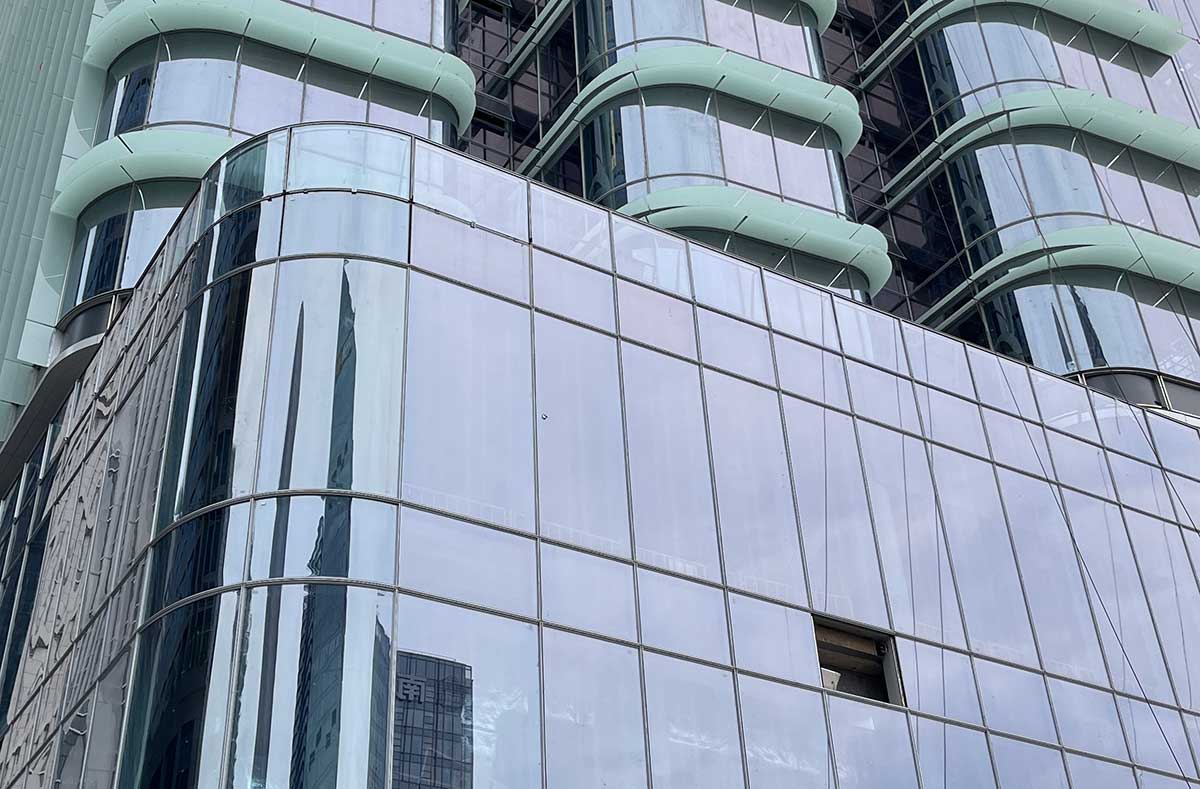As an important symbol of modern architecture, the glass curtain wall system not only shapes the city’s skyline, but also represents the integration of architectural technology and aesthetics. From its inception in the early 20th century to today’s intelligent application, the glass curtain wall system has become the preferred external protective structure for high-rise buildings, commercial complexes and cultural venues. Companies specializing in glass curtain walls will systematically analyze the glass curtain wall system from the aspects of definition, composition, type, advantages and disadvantages, application and development trend.
1. Definition and core features of glass curtain wall system
Definition: The glass curtain wall is a non-load-bearing exterior wall system composed of glass panels and supporting frames such as metal and stone. It only bears its own weight and external forces such as wind load and seismic force, and is fixed to the main structure of the building through connectors. Its core lies in transforming the shielding function of the traditional wall into a building interface that is both light-transmitting, decorative and functional.
Core features of glass curtain wall system:
1. Non-load-bearing: independent of the main structure of the building, only transfers load to the main body.
2. Lightweight: The combination of glass and lightweight metal frames significantly reduces the building’s deadweight.
3. Modular design: Standardized components facilitate factory prefabrication and on-site assembly.
4. Multifunctional integration: Ventilation, shading, energy saving and other technologies can be integrated.
2. Composition of glass curtain wall system
A complete glass curtain wall system consists of the following core components:
1. Support structure
Frame system: beams and columns made of aluminum alloy or steel, divided into exposed frames (exposed frames) and hidden frames (frames hidden inside the glass).
Point-supported structure: stainless steel connectors are used to fix the four corners of the glass to the steel truss or cable net to create a “floating” visual effect.
2. Glass panel
Substrate type:
Tempered glass: heat treatment is used to enhance strength, and after breaking, it is granular to reduce the risk of injury.
Laminated glass: PVB film is sandwiched between two pieces of glass, which is impact-resistant and prevents fragments from splashing.
LowE glass: coated with a low-emissivity film layer to reflect infrared rays to improve thermal insulation performance.
Hollow glass: Inert gas is filled between double or multiple layers of glass to reduce the heat transfer coefficient.
3. Sealing and connection materials
Structural adhesive: Used to bond glass and frame of hidden frame curtain wall, it must have high weather resistance.
Sealing strip: Fill the joints to prevent rainwater leakage, commonly used silicone or EPDM rubber.
Fasteners: Stainless steel bolts, anchor bolts, etc., to ensure stable connection of components.
4. Auxiliary system
Drainage channel: Design water guide groove to avoid water accumulation.
Fireproof structure: Fireproof rock wool is set between layers to block the spread of fire.
III. Main types and technical features of glass curtain wall system
1. Frame curtain wall
Exposed frame curtain wall: The frame is exposed, the structure is stable, and it is suitable for conventional high-rise buildings.
Hidden frame curtain wall: The frame is hidden, the glass is fixed with structural adhesive, and the appearance is simple and modern.
2. Point-supported curtain wall
The glass is fixed at a single point by claws to maximize the transparency of the glass. It is commonly seen in large-span spaces such as airports and theaters.
3. Unitized curtain wall
It is prefabricated in the factory into independent unit modules, hoisted and spliced on site, with high construction efficiency, suitable for super high-rise buildings.
4. All-glass curtain wall
There is no metal frame, and glass ribs are used as the supporting structure. It is mostly used at the entrance of shopping malls and exhibition halls.
5. Double-layer curtain wall (breathing curtain wall)
An air cavity is formed between the inner and outer layers of glass, and heat buffering is achieved through adjustable vents, which increases energy-saving efficiency by more than 30%.
6. Smart curtain wall
It integrates technologies such as electrochromic glass (such as dimmable glass) and photovoltaic power generation film to dynamically respond to environmental changes.
IV. Analysis of the advantages and disadvantages of glass curtain walls
Advantages:
1. Aesthetic value: giving buildings a sense of modernity and transparency, and reshaping the image of the city.
2. Natural lighting: Reduce energy consumption of artificial lighting and improve indoor comfort.
3. Convenient construction: Modular installation shortens construction period, especially unitized curtain wall can achieve “three floors a day”.
4. Energy saving potential: Combine LowE insulating glass and shading system to significantly reduce air conditioning load.
Challenges:
1. Thermal defects: Ordinary single-layer glass curtain wall is prone to “greenhouse effect” and needs to be optimized through technical upgrades.
2. Light pollution risk: High-reflectivity glass may interfere with the surrounding environment and low-reflection coating is required.
3. Maintenance cost: It is difficult to clean and replace broken glass at high altitude, and the later cost is high.
4. Safety hazards: Tempered glass self-explosion (about 0.3% probability), structural adhesive aging and other problems need to be regularly tested.
V. Application areas of glass curtain wall
1. Super high-rise landmarks: such as the double-layer curtain wall system of China’s Shanghai Tower, combined with wind dampers to resist typhoons.
2. Transportation hub: The point-supported glass dome of Beijing Daxing International Airport in China realizes natural lighting and spatial openness.
3. Commercial complex: The giant glass curtain wall of Apple flagship store strengthens the brand’s sense of technology.
4. Cultural architecture: The Louvre Pyramid combines history and modern aesthetics with glass curtain walls.
VI. Future development trends
1. Material innovation:
Electrochromic glass: adjusts light transmittance through voltage to dynamically balance lighting and insulation.
Photovoltaic curtain wall (BIPV): embeds solar cells into glass to achieve building capacity.


